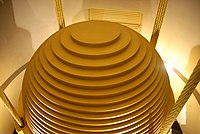
Photo from wikipedia
Abstract Using anti-motion structures is one of the most common methods of improving motion performance of cylindrical floating drilling production storage and offloading system (FDPSO). In order to study the… Click to show full abstract
Abstract Using anti-motion structures is one of the most common methods of improving motion performance of cylindrical floating drilling production storage and offloading system (FDPSO). In order to study the damping performance of annular anti-motion structures, basin model experiments and numerical simulations are carried out. By using six different annular anti-motion structures, the influence of different factors, including horizontal gaps, edges, and removal of horizontal plates are investigated. Numerical results are validated by the basin model test for further research. Specifically, with computational fluid dynamics (CFD) simulations the flow fields around the structures are presented and correlated with the experimental measurements. Results show that horizontal gaps can improve the damping performance, especially in roll. Meanwhile edges can also benefit the damping of anti-motion structure. With respect to the annular anti-motion structure, outer edges perform better than inner ones. Removing upper plate decreases the roll damping coefficients but removing lower plate increases it. In general, in order to maximize damping performance, outer edges and horizontal gaps can be added to annular anti-motion structures.
Journal Title: Ocean Engineering
Year Published: 2019
Link to full text (if available)
Share on Social Media: Sign Up to like & get
recommendations!